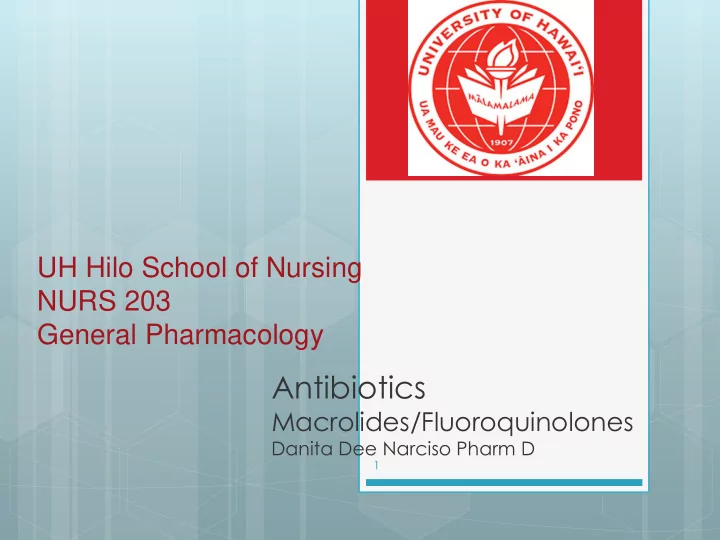

UH Hilo School of Nursing NURS 203 General Pharmacology Antibiotics Macrolides/Fluoroquinolones Danita Dee Narciso Pharm D 1
2 Objectives Become familiar with antibiotics that are commonly used and recognize areas of potential practical conflicts Recognize antibiotics that have interactions with other medications or illnesses Learn how to monitor for and adjust for changes in drug levels due to interactions with antibiotics
3 Macrolides – derived naturally from Steptomyces
4 Macrolides Bactericidal vs. bacteriostatic MOA Inhibits RNA synthesis by binding to 50s subunit Time dependent killing The bacteria’s defense Methylation mutation of bacterial RNA Production of drug inactivating enzymes Efflux pumps/decreased membrane permeability
5 Erythromycin Spectrum similar to PCN Gram positive organisms But also atypical bacteria Drug of choice for corynebacterial infections Respiratory Neonatal Ocular Genital chlamydial Community acquired pneumonia (CAP) Dosed Q 6 hours due to short half life Not first line Group A streptococci and pneumococci organisms Inhibits CYP 3A4 enzymes & ADRs
6 Clarithromycin Spectrum almost identical to erythromycin Increased Mycobacterium avium activity and Gram negatives Longer half life BID dosing Lower incidence of ADRs when compared to erythromycin Inhibits CYP 3A4 enzymes
7 Azithromycin Spectrum More closely related to that of clarithromycin Increased activity over H influenzae but decreased over Gram positives Pharmacokinetic differences Distribution Half-life Does not inhibit CYP enzymes
8 Macrolide - Kinetics Absorption Acid sensitive, delayed by food Distribution Most tissues CSF Metabolism Liver Kidney as metabolite and parent compound – clarithromycin Excreted in feces and urine
9 Adverse drug reactions GI disturbances – up to 33% Nausea, diarrhea, vomiting, dyspepsia Dermatologic Rash Fever QTc prolongation Cholestatic hepatitis - rare Ototoxicity – high dose erythromycin Bad taste – Clarithromycin
10 Drug-drug interactions Statins (L.A.S) Carbamazepine Warfarin (R) CCBs Buspirone Methadone and oxycodone Cyclosporine PDE5 inhibitors Benzodiazepines (not the L.O.T)
11 Allergy Normal hypersensitivity reaction symptoms Erythromycin Cholestatic hepatitis Telithromycin Ketolide Can be used in macrolide resistant strains
12 Fluoroquinolones – synthetic antibiotics
13 Fluoroquinolones Bactericidal vs. bacteriostatic MOA Inhibit DNA gyrase and topoisomerase IV Concentration dependent killing The bacteria’s defense (Resistance) Point mutations Membrane permeability Acetyltransferase Efflux pumps
14 First generation Nalidixic acid & norfloxacin Not active against Gram positive bacteria Poor oral absorption and tissue penetration May still be useful for: UTIs – E.coli, Proteus, Shigella, Enterobacter, Klebsiella
15 Second generation Ciprofloxacin & ofloxacin Gram negative coverage Even pseudomonas Limited Gram positive coverage Limited atypical coverage Used for: UTI, skin & soft tissue inf, bacterial diarrhea, bone, joint, intra-abdominal, and respiratory infections Resistance
16 Third generation Levofloxacin & gemifloxacin (Respiratory Fluoroquinolones) Less active against Gram negative Greater Gram positive coverage Including some MRSA stands Used for: UTI, skin & soft tissue inf, bacterial diarrhea, bone, joint, intra-abdominal, and respiratory infections Upper and lower respiratory tract – increased Gram positive
17 Fourth generation Moifloxacin Even greater Gram positive coverage Less coverage against pseudomonas and enterobacter May also be considered a “Respiratory Fluoroquinolone” Used for: UTI, skin & soft tissue inf, bacterial diarrhea, bone, joint, intra-abdominal, and respiratory infections Upper and lower respiratory tract – increased Gram positive
18 Fluoroquinolone - Kinetics Absorption Well absorbed Impaired by antacids Distribution Body fluids and tissues Half lives 3-10 hours Metabolism Kidney – most Liver - moxifloxacin Excretion Urine Feces and biliary excretion – moxifloxacin
19 Adverse drug reactions GI disturbances – 5% Nausea, diarrhea, vomiting, & dyspepsia Headache CNS Agitation, anxiety, seizure, confusion, insomnia, dizziness, panic attack, paranoia, hallucinations, and toxic psychosis Peripheral neuropathy – rare Irreversible Hepatotoxicity – hepatic failure, cholestatic hepatitis (levo, cipro, moxi) Cardiovascular Prolong QTc interval (moxifloxacin > ciprofloxacin)
20 Notable Dermatologic Severe hypersensitivity reactions Some of the older generations will cause photo toxicity A dermatologic reaction to a fluoroquinolone can make a patient more sensitive to more severe adverse drug reactions.
21 Fluoroquinolones Black Box Warning Increased likelihood of tendon rupture Most at risk 60 years of age or greater Also taking systemic corticosteroids Transplant patients (kidney, heart, or lungs) Stop immediately if pain, swelling, inflammation or rupture
22 Drug-drug interactions Antacids or supplements Ca, Fe, Mg, Al, Zn CYP1A2 inhibition Ciprofloxacin Caffeine, theophylline, cyclosporine, warfarin, duloxetine, clozapine NSAIDs Benzodiazepine-dependent patients Withdrawal Super infection MRSA, C diff
23 Questions ?????????????????????????????????? ?????????????????????????????????? ?????????????????????????????????? ?????????????????????????????????? ?????????????????????????????????? ?????????????????????????????????? ?????????????????????????????????? ?????????????????????????????????? ??????????????????????????????????
Recommend
More recommend